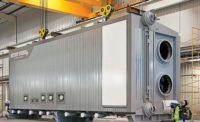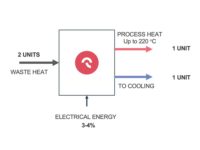
How does it work? Have a look, including a quick tour of a Canadian project where the technology drives down emissions and preserves more usable energy.
There are many industrial processes that exhaust economically significant quantities of “waste” energy into the environment. This waste heat, depending on its quality, can be an excellent source to generate heat and/or power. Steam turbine cycle systems generally require higher grade heat, but in the absence of this/and or a need for heat for onsite needs, an Organic Rankine Cycle (ORC) system can generate electricity from waste heat streams at temperatures less than 1,000ºF. This generation results in no incremental emissions while providing electrical energy and dependable capacity into the electrical system
Gas compression stations utilize turbines to pressure the transmission pipelines. Approximately 60% of the fuel energy is lost to waste heat in these applications. The exhaust gas from these turbines is an ideal source for heat recovery.
A schematic of a bottoming plant based on an ORC is shown in Figure 1 for heat recovery from a gas turbine. The organic motive fluid is selected to optimize power output for the gas turbine exhaust. Thermal energy in the waste heat stream is transferred to the ORC’s vaporizer by a nonflammable heat transfer fluid flowing through the waste heat recovery unit (WHRU). The ORC working fluid is vaporized by the heat transfer fluid. The resulting organic vapor drives the turbine, which is coupled to the generator, or an additional compressor. The turbine exhaust vapor flows through the recuperator, is condensed, and then is recycled by the motive fluid pump.

ORC IN BC
Kentube Engineered Products recently designed, engineered, and fabricated two WHRUs, (inclusive of the inlet and outlet ductwork, stacks, ladders, platforms, and stacks) for such an ORC system (Figure 2).The units were installed at Spectra Energy’s Savona and 150 Mile House Compression stations in British Columbia, Canada. The site had G.E. de-rated LM 2,500 (2,000) gas turbines producing about 500,000 lb/hr of exhaust at up to 1,000ºF.
Therminol 55 was the tube-side heat transfer fluid, and the units were built to ASME codes. The WHRU had externally finned carbon steel tubes with structural material capable of handling gas-side design temperatures. Thermal design had to be careful to not exceed the recommended maximum film temperatures for the heat transfer fluid. Given the low freezing temperatures of the organic fluid, such units are suitable for outdoor installations in cold climates.
The units have commissioned successfully and have been operating for nearly a year now. Each of these WHRUs is designed to recover enough energy to generate 5 MW power (for a total of 10 MW) that could be sold back to the grid. Moreover, this clean electricity is enough to power approximately 10,000 homes a year. The greenhouse gas emissions offset by this generation is about 25,000 tons a year.
In addition to reducing operating costs for the compressor operator, there is a potential to create and use greenhouse gas emissions credits from this.
Beyond gas compression stations, opportunities exist in many other applications like cement plants, etc., to generate power with zero-emission and very low environmental impact.TB





